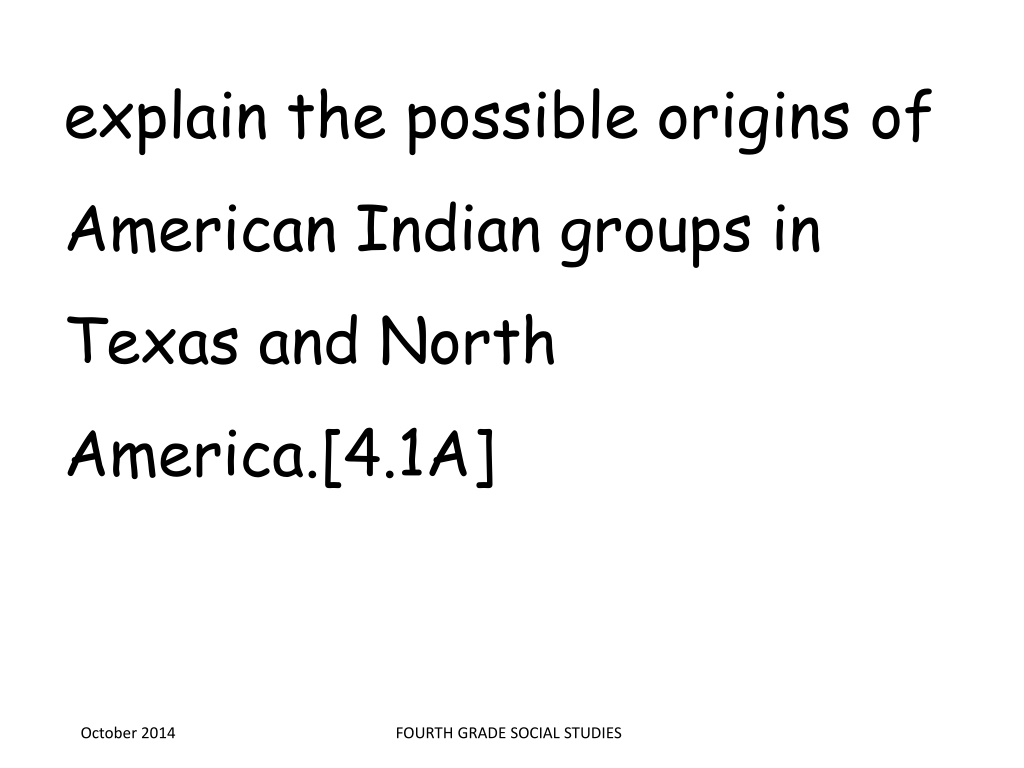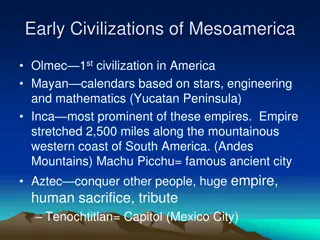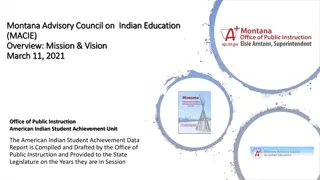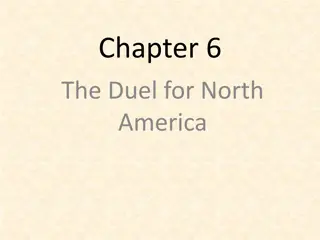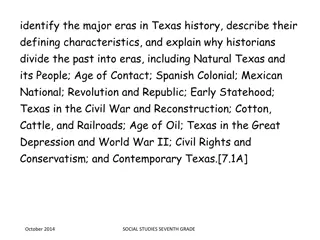Early History of American Indian Groups in Texas and North America
This content delves into the origins, identification, regions, and ways of life of American Indian groups in Texas and North America before European exploration. It also covers motivations for European exploration, settlement of Texas, significant explorers, Spanish settlements and missions in Texas, Texas's role in the Mexican War of Independence, and its impact on development.
Download Presentation

Please find below an Image/Link to download the presentation.
The content on the website is provided AS IS for your information and personal use only. It may not be sold, licensed, or shared on other websites without obtaining consent from the author. Download presentation by click this link. If you encounter any issues during the download, it is possible that the publisher has removed the file from their server.
E N D
Presentation Transcript
explain the possible origins of American Indian groups in Texas and North America.[4.1A] October 2014 FOURTH GRADE SOCIAL STUDIES
identify American Indian groups in Texas and North America before European exploration such as the Lipan Apache, Karankawa, Caddo, and Jumano.[4.1B] October 2014 FOURTH GRADE SOCIAL STUDIES
describe the regions in which American Indians lived and identify American Indian groups remaining in Texas such as the Ysleta Del Sur Pueblo, Alabama- Coushatta, and Kickapoo.[4.1C] October 2014 FOURTH GRADE SOCIAL STUDIES
compare the ways of life of American Indian groups in Texas and North America before European exploration.[4.1D] October 2014 FOURTH GRADE SOCIAL STUDIES
summarize motivations for European exploration and settlement of Texas, including economic opportunity, competition, and the desire for expansion.[4.2A] October 2014 FOURTH GRADE SOCIAL STUDIES
identify the accomplishments and explain the impact of significant explorers, including Cabeza de Vaca; Francisco Coronado; and Ren Robert Cavelier, Sieur de la Salle, on the settlement of Texas.[4.2B] October 2014 FOURTH GRADE SOCIAL STUDIES
explain when, where, and why the Spanish established settlements and Catholic missions in Texas as well as important individuals such as Jos de Escand n.[4.2C] October 2014 FOURTH GRADE SOCIAL STUDIES
identify Texas' role in the Mexican War of Independence and the war's impact on the development of Texas.[4.2D] October 2014 FOURTH GRADE SOCIAL STUDIES
identify the accomplishments and explain the economic motivations and impact of significant empresarios, including Stephen F. Austin and Mart n de Le n, on the settlement of Texas.[4.2E] October 2014 FOURTH GRADE SOCIAL STUDIES
analyze the causes, major events, and effects of the Texas Revolution, including the Battle of the Alamo, the Texas Declaration of Independence, the Runaway Scrape, and the Battle of San Jacinto.[4.3A] October 2014 FOURTH GRADE SOCIAL STUDIES
summarize the significant contributions of individuals such as Texians William B. Travis, James Bowie, David Crockett, George Childress, and Sidney Sherman; Tejanos Juan Antonio Padilla, Carlos Espalier, Juan N. Segu n, Pl cido Benavides, and Jos Francisco Ruiz; Mexicans Antonio L pez de Santa Anna and Vicente Filisola; and non-combatants Susanna Dickinson and Enrique Esparza.[4.3B] October 2014 FOURTH GRADE SOCIAL STUDIES
identify leaders important to the founding of Texas as a republic and state, including Jos Antonio Navarro, Sam Houston, Mirabeau Lamar, and Anson Jones.[4.3C] October 2014 FOURTH GRADE SOCIAL STUDIES
describe the successes, problems, and organizations of the Republic of Texas such as the establishment of a constitution, economic struggles, relations with American Indians, and the Texas Rangers.[4.3D] October 2014 FOURTH GRADE SOCIAL STUDIES
explain the events that led to the annexation of Texas to the United States, including the impact of the U.S.- Mexican War.[4.3E] October 2014 FOURTH GRADE SOCIAL STUDIES
describe the impact of the Civil War and Reconstruction on Texas.[4.4A] October 2014 FOURTH GRADE SOCIAL STUDIES
explain the growth, development, and impact of the cattle industry, including contributions made by Charles Goodnight, Richard King, and Lizzie Johnson.[4.4B] October 2014 FOURTH GRADE SOCIAL STUDIES
identify the impact of railroads on life in Texas, including changes to cities and major industries.[4.4C] October 2014 FOURTH GRADE SOCIAL STUDIES
examine the effects upon American Indian life resulting from changes in Texas, including the Red River War, building of U.S. forts and railroads, and loss of buffalo.[4.4D] October 2014 FOURTH GRADE SOCIAL STUDIES
identify the impact of various issues and events on life in Texas such as urbanization, increased use of oil and gas, the Great Depression, the Dust Bowl, and World War II.[4.5A] October 2014 FOURTH GRADE SOCIAL STUDIES
explain the development and impact of the oil and gas industry upon industrialization and urbanization in Texas, including important places and people such as Spindletop and Pattillo Higgins.[4.5B] October 2014 FOURTH GRADE SOCIAL STUDIES
identify the accomplishments of notable individuals such as John Tower, Scott Joplin, Audie Murphy, Cleto Rodr guez, Stanley Marcus, Bessie Coleman, Raul A. Gonzalez Jr., and other local notable individuals.[4.5C] October 2014 FOURTH GRADE SOCIAL STUDIES
apply geographic tools, including grid systems, legends, symbols, scales, and compass roses, to construct and interpret maps.[4.6A] October 2014 FOURTH GRADE SOCIAL STUDIES
translate geographic data, population distribution, and natural resources into a variety of formats such as graphs and maps.[4.6B] October 2014 FOURTH GRADE SOCIAL STUDIES
describe a variety of regions in Texas and the United States such as political, population, and economic regions that result from patterns of human activity.[4.7A] October 2014 FOURTH GRADE SOCIAL STUDIES
identify, locate, and compare the geographic regions of Texas (Mountains and Basins, Great Plains, North Central Plains, Coastal Plains), including their landforms, climate, and vegetation.[4.7B] October 2014 FOURTH GRADE SOCIAL STUDIES
compare the geographic regions of Texas (Mountains and Basins, Great Plains, North Central Plains, Coastal Plains) with regions of the United States and other parts of the world.[4.7C] October 2014 FOURTH GRADE SOCIAL STUDIES
identify and explain clusters and patterns of settlement in Texas at different time periods such as prior to the Texas Revolution, after the building of the railroads, and following World War II.[4.8A] October 2014 FOURTH GRADE SOCIAL STUDIES
describe and explain the location and distribution of various towns and cities in Texas, past and present.[4.8B] October 2014 FOURTH GRADE SOCIAL STUDIES
explain the geographic factors such as landforms and climate that influence patterns of settlement and the distribution of population in Texas, past and present.[4.8C] October 2014 FOURTH GRADE SOCIAL STUDIES
describe ways people have adapted to and modified their environment in Texas, past and present, such as timber clearing, agricultural production, wetlands drainage, energy production, and construction of dams.[4.9A] October 2014 FOURTH GRADE SOCIAL STUDIES
identify reasons why people have adapted to and modified their environment in Texas, past and present, such as the use of natural resources to meet basic needs, facilitate transportation, and enhance recreational activities.[4.9B] October 2014 FOURTH GRADE SOCIAL STUDIES
compare the positive and negative consequences of human modification of the environment in Texas, past and present, both governmental and private, such as economic development and the impact on habitats and wildlife as well as air and water quality.[4.9C] October 2014 FOURTH GRADE SOCIAL STUDIES
explain the economic activities various early American Indian groups in Texas and North America used to meet their needs and wants such as farming, trading, and hunting.[4.10A] October 2014 FOURTH GRADE SOCIAL STUDIES
explain the economic activities early immigrants to Texas used to meet their needs and wants.[4.10B] October 2014 FOURTH GRADE SOCIAL STUDIES
describe the development of the free enterprise system in Texas.[4.11A] October 2014 FOURTH GRADE SOCIAL STUDIES
describe how the free enterprise system works, including supply and demand.[4.11B] October 2014 FOURTH GRADE SOCIAL STUDIES
give examples of the benefits of the free enterprise system such as choice and opportunity.[4.11C] October 2014 FOURTH GRADE SOCIAL STUDIES
explain how people in different regions of Texas earn their living, past and present, through a subsistence economy and providing goods and services.[4.12A] October 2014 FOURTH GRADE SOCIAL STUDIES
explain how geographic factors such as climate, transportation, and natural resources have influenced the location of economic activities in Texas.[4.12B] October 2014 FOURTH GRADE SOCIAL STUDIES
analyze the effects of exploration, immigration, migration, and limited resources on the economic development and growth of Texas.[4.12C] October 2014 FOURTH GRADE SOCIAL STUDIES
describe the impact of mass production, specialization, and division of labor on the economic growth of Texas.[4.12D] October 2014 FOURTH GRADE SOCIAL STUDIES
explain how developments in transportation and communication have influenced economic activities in Texas.[4.12E] October 2014 FOURTH GRADE SOCIAL STUDIES
explain the impact of American ideas about progress and equality of opportunity on the economic development and growth of Texas.[4.12F] October 2014 FOURTH GRADE SOCIAL STUDIES
identify ways in which technological changes in areas such as transportation and communication have resulted in increased interdependence among Texas, the United States, and the world.[4.13A] October 2014 FOURTH GRADE SOCIAL STUDIES
identify oil and gas, agricultural, and technological products of Texas that are purchased to meet needs in the United States and around the world.[4.13B] October 2014 FOURTH GRADE SOCIAL STUDIES
explain how Texans meet some of their needs through the purchase of products from the United States and the rest of the world.[4.13C] October 2014 FOURTH GRADE SOCIAL STUDIES
compare how various American Indian groups such as the Caddo and the Comanche governed themselves.[4.14A] October 2014 FOURTH GRADE SOCIAL STUDIES
identify and compare characteristics of the Spanish colonial government and the early Mexican governments and their influence on inhabitants of Texas.[4.14B] October 2014 FOURTH GRADE SOCIAL STUDIES
identify the purposes and explain the importance of the Texas Declaration of Independence, the Texas Constitution, and other documents such as the Meusebach- Comanche Treaty.[4.15A] October 2014 FOURTH GRADE SOCIAL STUDIES
identify and explain the basic functions of the three branches of government according to the Texas Constitution.[4.15B] October 2014 FOURTH GRADE SOCIAL STUDIES
